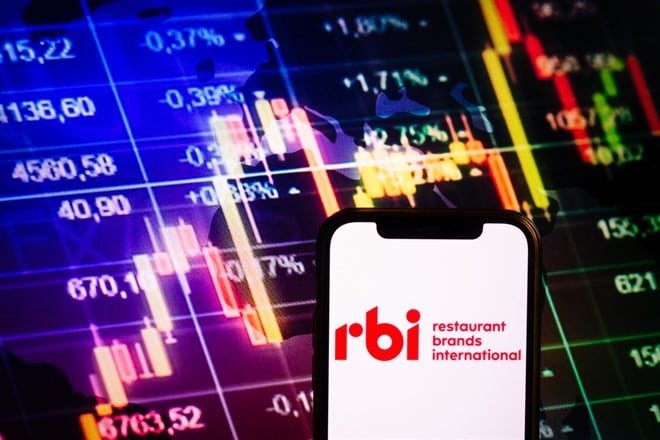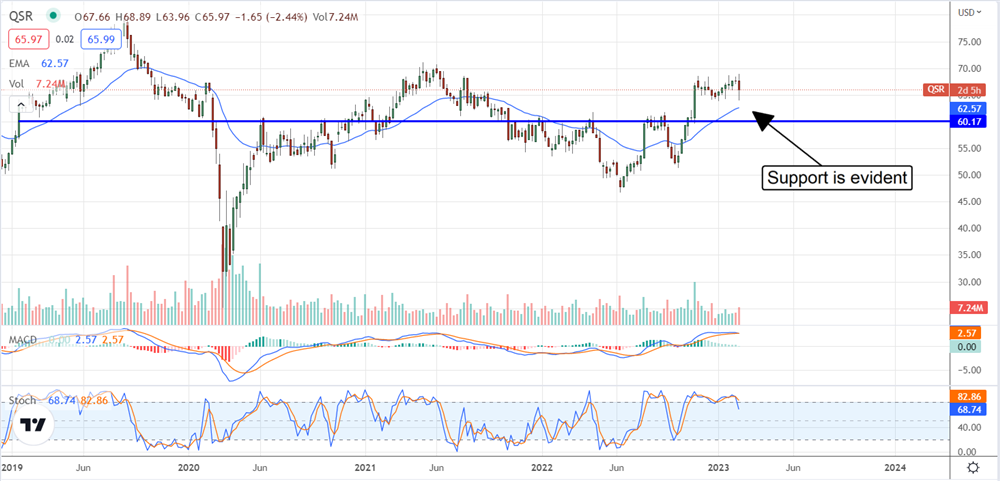
Restaurant Brands International (NYSE: QSR) issued a mixed q4 report and is still facing headwinds, but that is no deterrent for the analysts. At least 6 sell-side analysts have come out with commentary since the Q4 release, and all support the price action. There were no upgrades or downgrades, and the activity includes 2 price target reductions, but all are above the Marketbeat.com consensus estimate.
The consensus estimate is trending higher on this activity and commentaries issued over the last 2 quarters and not only implies upside for the market but is quickly approaching the highs set last year.
The $68.53 consensus target is barely above the current price action. The takeaway is that this target coincides with the post-COVID highs in the stock price and is trending higher. If this trend continues, it will support the market and may help it to break out to new highs.
The stock is highly valued at this level, trading about 22X its earnings, but this is consistent with the restaurant market, so it may not be a concern now. McDonald’s (NYSE: MCD) and Yum! Brands (NYSE: YUM) both trade near 25X earnings and represent the 2 most prominent fast food franchises on the planet, while quick-serve sit-down brand Denny’s (NASDAQ: DENN) trades at 19X earnings. Because McDonald’s and Yum! Brands pay dividends with yields below Restaurant Brands International it may even be under-valued.
Restaurant Brands Has Mixed Quarter
Restaurant Brands had a good quarter, but 1 in which the strengths were priced in and 1-off factors cut into the bottom line. The company reported $1.69 billion in net revenue for a gain of 9.7% versus last year. The gains were driven by strength in Tim Hortons, which is getting a boost from improving traffic, and strength in Burger King International. Regardless, all segments posted double-digit YOY growth except the recently acquired Firehouse Subs, which grew by low single digits.
Global system-wide sales growth topped 12% but was impacted by FX headwinds. The systemwide comp came in at 8% and was boosted by a strong year of expansion. Popeyes, in particular, saw its strongest year of growth since the brand was brought into the QSR fold. On a channel basis, the digital channels grew by 30% and are now more than 33% of the net revenue. The company’s strategies are working.
The margin is where the news is mixed, but there is a mitigating factor. The isolation of Russian businesses had a 2% impact on the EBITDA margin. That, along with cost pressures, resulted in EPS of $0.72, which is $0.02 below the consensus.
The salient point is that earnings and cash flow remain robust and allow aggressive expansion, investment in the Reach The Flame turnaround plan, dividend increases and a reduction in net-debt leverage. Those are all positives for the stock price long term.
Capital Returns Help Support QSR Share Prices
Restaurant Brands International’s dividend is attractive enough for its 3.35% yield but is also growing. The company has been growing the yield aggressively over the past few years, but this may stop. The payout ratio is sufficiently high at 68%, so a 20% CAGR should not be expected to continue. The 2% increase announced with the Q4 results is more in-line with the long-term outlook.
The chart shows QSR is range bound but trading at the top end of that range following an upswing. The Q4 results sparked a sell-off in the stock, but support is already evident above key levels like the 150-day moving average and $60, a critical post-COVID pivot point for the market. Assuming the market stays interested in this company, the stock should move sideways and even break above $70.
